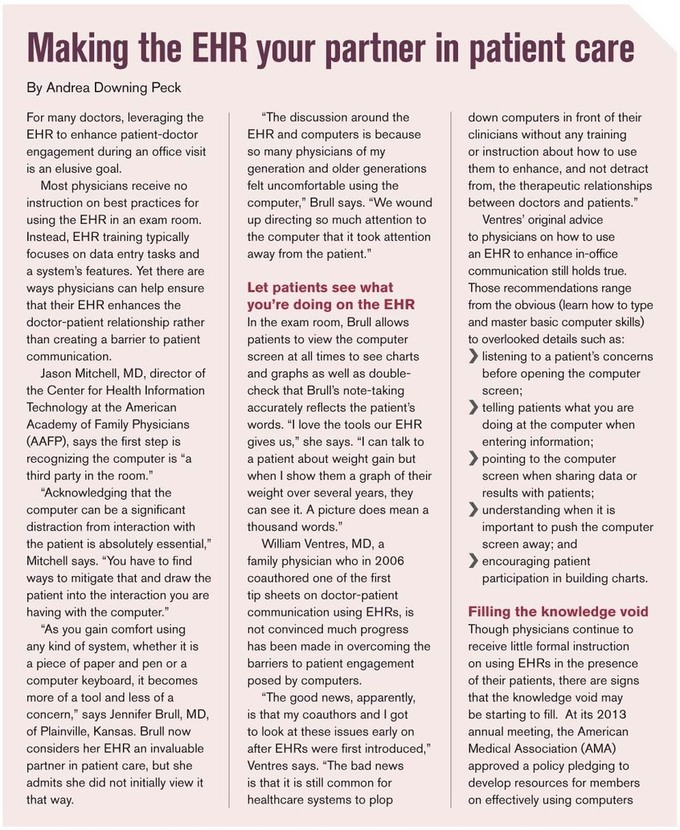
Patient adherence and the EHR
This clinical vignette reflects the reality that only one-quarter to one-third of patients follow up as directed after ED visits.1 Thus, dependence on patient adherence to care recommendations will continue to result in missed opportunities for both health maintenance and disease prevention. The EHR, which might have provided a safety net in this instance, failed to do so because an otherwise conscientious physician did not document a suspected diagnosis. In this case, the EHR’s utility was significantly limited by incomplete data entry.
How might the EHR have altered the course of events that led to the adverse reproductive outcome in this patient? Had the suspected diagnosis of diabetes been recorded, subsequent caregivers would have had the opportunity to see it in the problem list and to have acted upon it. Incomplete ED documentation effectively thwarted one of the putative “virtues” of this technology, namely, linkage of health information directly to the patient rather than to the provider of care.
Data not entered in the electronic chart or hidden from view are equivalent to a paper record locked in a medical office filing cabinet or a hospital’s health records department. In either circumstance, important patient information is unavailable precisely because it is sequestered by the care provider.
Disease prevention and the EHR
In response to anecdotal evidence as well as evidence supporting the effectiveness of prenatal health promotion,2,3 we evaluated our own EHR for its potential to help our patients avoid adverse outcomes.
Recognizing the frequency of unplanned pregnancy and the fact that 30% of women who conceive have modifiable risk factors that could be treated to improve pregnancy outcome,3 we created a case-finding algorithm to screen all outpatient encounters from our health system’s unified EHR (EPIC, Verona, WI).
Patient data are routinely transferred each evening into an enterprise-wide data warehouse (EPIC Clarity with Oracle and IBM COGNOS) allowing for subsequent data mining for quality improvement, care innovation and research.
We sought to identify reproductive-age women of child-bearing potential and use their data entries to identify risk factors for adverse maternal or fetal outcome. Child-bearing potential was defined as women of reproductive age lacking a history of either sterilization or hysterectomy, and without documented contraceptive use, while the preconception risk factors chosen included morbid obesity, hypertension, poorly controlled diabetes, anemia, renal insufficiency, teratogen exposure, and alcohol, tobacco and illicit drug use.
The algorithm was designed to mitigate incomplete charting by cross-referencing multiple electronic data fields (problem lists, medical and surgical histories, clinical diagnoses, laboratory results, medication orders, and ICD-9 codes), so that multiple dimensions of the record for each risk factor were queried.4
Where the EHR falls short
Although our case-finding strategy showed promise, accurate identification of women of child-bearing potential was problematic because up to 25% of patients were incorrectly classified due to incomplete electronic records.4 Poor data quality has been noted by others to confound the EHR5,6 and administrative databases from insurance claims and birth certificates are also notorious for missing information.7
In the domain of funded clinical research, a standard for precise data entry has existed for decades. Agencies including the National Institutes of Health place great emphasis on complete data capture and auditing, often insisting on robust data monitoring committees for just this purpose.
One needs only to reflect on the new norm of electronic banking to realize how important data precision is to our wealth, but, apparently, not yet to our health.
We believe it is time to insist that electronic medical records are assiduously created and carefully maintained so that they are more than just expensive versions of their paper ancestors. We suggest that caregivers need to conceptualize data entered on behalf of patients as of the highest value to their current and future health status, making accurate completion of the EHR an act of professionalism.
It is not a coincidence that Stage I meaningful use criteria include proper utilization of the problem list as an essential element in electronic recordkeeping.8 Accurate and comprehensive charting is no different than other measures designed to improve patient health and safety. While the activity may not feel particularly important on its face, our clinical vignette should leave no doubt as to the potential consequences of getting this wrong.
- See more at: http://contemporaryobgyn.modernmedicine.com/contemporary-obgyn/news/what-s-missing-electronic-health-record#sthash.3xGtRfc6.dpuf
by Shane Turner via NursingFacultyJobs.com
No comments:
Post a Comment